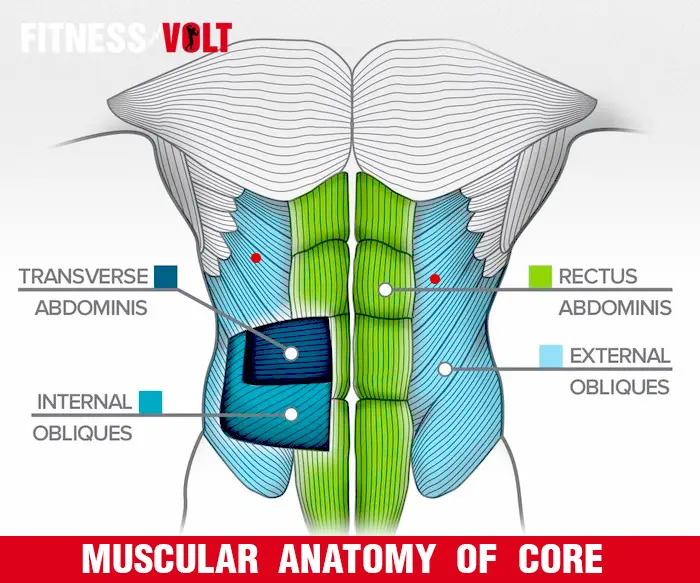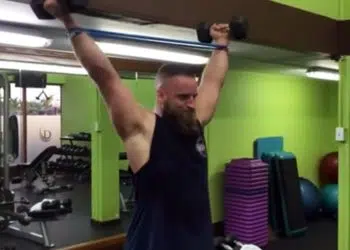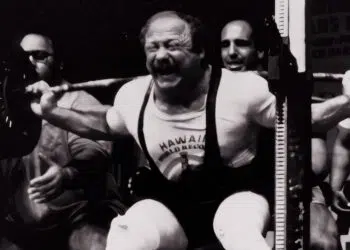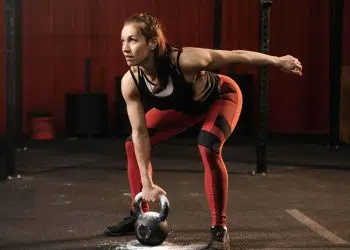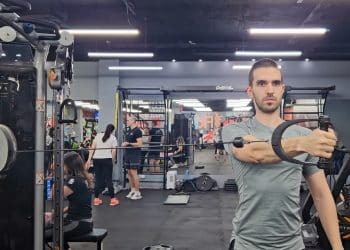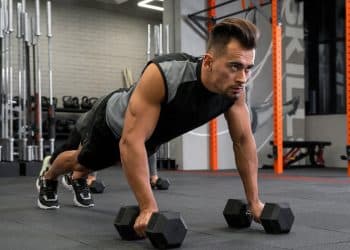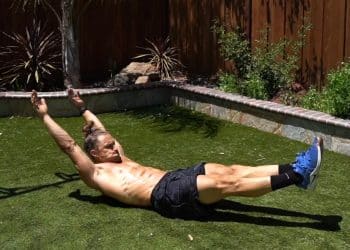Planks are one of the most popular core exercises of all time. Originating in yoga and popularized by Pilates, planks feature in many workouts and are a staple of group exercise classes.
They’re relatively simple, so almost all levels of exerciser can do them. Beginners plank for just a few seconds, while more advanced exercisers can often plank for five minutes or more. The current planking world record is a staggering nine and a half hours.
And therein lies the problem with planks!
As you get stronger, your main source of progression is to plank for longer and longer durations. That’s okay when your sets last a minute or so, but longer holds can soon become boring and aren’t an efficient use of your training time.
After all, the purpose of any exercise is to fatigue the target muscles. If it takes you five minutes to reach this point, you’ve basically wasted four minutes that could have been used more constructively.
You could try weighted planks to make your workouts more efficient, but that’s not always practical.
Level Up Your Fitness: Join our 💪 strong community in Fitness Volt Newsletter. Get daily inspiration, expert-backed workouts, nutrition tips, the latest in strength sports, and the support you need to reach your goals. Subscribe for free!
The good news is there is another way to make planks harder – the wall plank.
In this article, we reveal why and how to do wall planks and provide you with a few variations and alternatives to try.
Wall Plank – Muscles Worked
Wall planks are an isometric core exercise. This means they involve plenty of muscle tension but no actual movement. Your muscles work statically rather than dynamically.
While this may sound like a disadvantage, it’s worth noting that your core muscles often function this way when they stabilize your spine while your arms and legs move. As such, wall planks are a very functional core exercise that should carry over well to activities outside of the gym.
The main muscles trained by wall planks are:
Rectus abdominus
Located at the front of your abdomen, the rectus abdominis is the most prominent core muscle. Long and flat, it’s responsible for flexion and lateral flexion of your spine and also plays a role in the compression of the abdominal contents. During wall planks, the rectus abdominis works hard to prevent the extension of your spine, making wall planks an anti-extension exercise.
The rectus abdominis is divided into sections by lines of ligamentous tissue, which give it a unique six-pack appearance. However, you’ve got to be pretty lean for this outline of your abs to be visible.
The rectus abdominis is where most people feel wall planks working. However, there are other muscles involved, too.
Transverse abdominis
Known as the TVA for short, this muscle runs horizontally or transversely around your midsection like a wide weightlifting belt. When it contracts, the TVA squeezes inward to create intra-abdominal pressure, which provides your lumbar spine with support. You might not feel the TVA working, but it’s very involved in wall planks.
External and internal obliques
The external and internal obliques are essentially your waist muscles. Working together, the external and internal obliques are responsible for lateral flexion and rotation of your spine. During wall planks their primary function is stabilizing your lumbar spine and preventing unwanted twisting.
Quadriceps
While wall planks are undoubtedly a core exercise, you’ll need to use several other body parts to perform them correctly. Keeping your legs straight is the job of your quadriceps or quads for short. Located on the fronts of your thighs, the four quadriceps muscles are rectus femoris, vastus lateralis, vastus intermedius, and vastus medialis. You’ll need to tense your quads to stop your knees from bending.
Upper body
Wall planks are performed in a static push-up or high plank position, and you must use your arms and shoulders to push your feet back and into the wall so they don’t slide down. This means that wall planks involve several upper body muscles.
The main upper body muscles involved in wall planks are:
- Deltoids – shoulder muscles
- Pectoralis major – chest muscles
- Triceps – muscles on the rear of the upper arms
How to Do Wall Planks
Get more from wall planks while keeping your risk of injury to a minimum by following these guidelines:
- Adopt the push-up position with your feet touching the bottom of a smooth wall. Brace your core, pull your shoulders down and back, and press your hands forward to engage your shoulders.
- Pushing back with your arms, walk your feet up the wall until they’re level or slightly above your shoulders.
- Hold the position (but not your breath!) for as long as possible.
- Walk your feet back down to the floor, bend your knees, and relax.
Pro Tips:
- Use a textured wall to stop your feet from slipping and make this exercise easier to perform.
- Clean the soles of your shoes, removing dust or lifting chalk residue to ensure your feet don’t slip.
- Experiment with a wide, medium, or narrow hand position to see which you prefer.
- Take care not to arch your lower back, as doing so could make this exercise uncomfortable and even dangerous.
- Look straight down at the floor when doing wall planks. Lifting your head puts undue stress on your neck.
- Take care not to leave footprints on the walls of your gym! This exercise is best done on an external wall.
- You can also do this exercise with your feet pressed against a broad pillar or even a thick tree trunk. Almost any vertical surface will suffice.
Wall Plank Benefits and Drawbacks
Not sure if wall planks are worthy of a place in your workouts? Consider these benefits and then decide!
A good progression from regular planks
While there is nothing wrong with regular planks, they are not all that challenging once you’ve been doing them for a while. Holding planks for longer makes them harder, but that can soon become boring.
Wall planks are more challenging than the regular version and are a great way to make your workouts more progressive and productive.
A more intense upper body workout
Wall planks are definitely a core exercise, but they also work your upper body, especially your shoulders. Some exercisers may find that they feel their deltoids working almost as hard as their abs during wall planks. If you stop pushing with your arms, your feet will soon start to slide down the wall!
A functional core exercise
All types of planks are highly functional. That means they replicate movements often seen in sports or general non-gym activities. During planks, you must use your core muscles to stabilize your lumbar spine. This is one of their regular tasks. Training your core in this way can improve athletic performance and may reduce your risk of back pain and injury.
Better looking abs
While we can’t promise that wall planks will give you a six-pack, training your abs should lead to a firmer, flatter, better-looking midsection. However, if you want to SEE the outline of your abs, you may need to shed some body fat so the details and outlines can show through.
A new workout challenge
It’s hard to get motivated when your workout is boring. Facing yet another set of regular planks could mean you dread your gym session. Adding new exercises to your workouts is one of the best ways to stay motivated. Will YOU rise to the challenge?
No equipment required
Lack of time and facilities are two common barriers to working out. Wall planks require no special equipment, so you can do them almost anywhere – even at home. Because of this, there is no real excuse for skipping workouts.
While wall planks are a beneficial and effective exercise, there are also a few drawbacks to consider:
Level Up Your Fitness: Join our 💪 strong community in Fitness Volt Newsletter. Get daily inspiration, expert-backed workouts, nutrition tips, the latest in strength sports, and the support you need to reach your goals. Subscribe for free!
A challenging exercise
Wall planks are quite a step up from regular planks. Some exercisers may find them too demanding or that they are unable to do them correctly. Don’t worry, though; there are still plenty of planking alternatives and variations left for you to try.
Upper body strength may be a limiting factor
Wall planks require a strong upper body. If you don’t push back hard enough, you may find your feet slipping down the wall, bringing your core workout to an early end. As such, some exercisers may find their upper body strength fails before their core.
You need the right kind of wall
You should not do this exercise against a plasterboard wall, as you may damage it. Similarly, your feet will probably leave marks on light-colored walls. Depending on where you work out, you may not have a suitable place for this challenging planking exercise.
7 Wall Plank Variations and Alternatives
Wall planks are a highly effective core exercise, but that doesn’t mean you need to do them all the time. There are several variations and alternatives you can use to keep your workouts productive and interesting:
1. High plank
Before you attempt a wall plank, you should be able to hold a high plank for several minutes. This will ensure your shoulders, arms, and core are ready for what’s coming next. Consciously drive your hands into the floor and engage your shoulders to practice using your upper body during planks.
Steps:
- Kneel on the floor and place your palms flat, fingers pointing forward. Your hands should be roughly shoulder-width apart. Brace your core and engage your upper body.
- Walk your feet out and back into a push-up position so your body and arms are straight.
- Hold this position for as long as possible.
- Bend your legs, lower your knees to the floor, and rest.
Muscles Targeted:
- Primary: Rectus abdominis, transverse abdominis, obliques.
- Secondary: Triceps, deltoids.
Benefits:
- An excellent preparatory exercise for wall planks.
- A very functional core exercise.
- A useful progression from regular planks.
Tips:
- Bend your legs and lower your knees to the floor to make this exercise easier.
- Rest a weight plate across your lower back to make this move harder.
- Do not hold your breath.
2. Feet on the wall push-ups
Wall planks involve more upper-body engagement than regular planks. However, you can work your upper body even more by adding push-ups into the mix. The challenging exercise will blitz your core and pump up your pecs in minutes.
Steps:
- Adopt the push-up position with your feet touching the bottom of a smooth wall. Brace your core, pull your shoulders down and back, and press your hands forward to engage your shoulders.
- Pushing back with your arms, walk your feet up the wall until they’re level or slightly above your shoulders.
- Bend your arms and lower your chest to the floor.
- Extend your arms and return to the starting position.
- Continue for the required number of reps.
Muscles Targeted:
- Primary: Pectoralis major, triceps, deltoids.
- Secondary: Rectus abdominis, transverse abdominis, obliques.
Benefits:
- A challenging upper-body and core combo.
- A more demanding way to do push-ups and wall planks.
- An excellent exercise for circuit and HIIT workouts.
Tips:
- Experiment with a close, medium, and wide grip to see which you prefer.
- You can also do this exercise using push-up handles or parallettes.
- Walk your feet higher up the wall to put more weight on your hands and make this exercise more challenging.
3. Tyson push-ups
If you don’t quite have the upper body strength to hold a wall plank, Tyson push-ups may help. This bodyweight exercise was a favorite of legendary boxer Mike Tyson and is a great way to improve your strength for wall planks. After a few weeks of Tyson push-ups, you’ll soon more than ready to crush some wall planks.
Steps:
- Adopt the push-up position with your feet flat against the bottom of a wall. Brace your core.
- Bend your arms and lower your chest to the floor.
- Next, bend your knees and hips and use your arms to push your butt back toward the wall.
- Push with your legs and return to the push-up position.
- That’s one rep – keep going!
Muscles Targeted:
- Primary: Pectoralis major, triceps, deltoids.
- Secondary: Rectus abdominis, transverse abdominis, obliques.
Benefits:
- More overload on the upper body.
- A good exercise for improving shoulder mobility.
- A handy steppingstone toward a stronger wall plank.
Tips:
- Experiment with a close, medium, and wide hand placement to see which you prefer.
- Push harder with your legs to overload your arms and shoulders.
- Pause in the high plank position to emphasize your core.
4. Wall walks
The wall walk is a popular exercise from CrossFit. It combines wall planks, push-ups, and handstands to provide an intense core and upper-body workout. Only attempt this exercise if you have mastered wall planks and wall push-ups, and feel confident to do a wall-assisted handstand.
Steps:
- Adopt the push-up position with your feet touching the bottom of a smooth wall. Brace your core, pull your shoulders down and back, and press your hands forward to engage your shoulders.
- Pushing back with your arms, walk your feet up until your body is vertical and lightly touching the wall.
- Walk your hands forward and your feet down to return to the push-up position.
- Continue for the required number of reps.
Muscles Targeted:
- Primary: Pectoralis major, triceps, deltoids.
- Secondary: Rectus abdominis, transverse abdominis, obliques.
Benefits:
- A fun and challenging core/upper body exercise.
- Good for developing balance and coordination.
- A useful precursor to handstands.
Tips:
- Start this exercise from a prone position (arms bent) to make it more challenging.
- Keep your arms relatively straight to avoid tiring out your triceps too quickly.
- Have a spotter nearby who can help you with your balance the first time you try this exercise.
5. Hardstyle/RKC plank
No wall? No problem! There is more than one way to make planks more challenging. The hardstyle or RKC plank involves tensing your muscles much harder than usual, delivering a more intense core workout in less time. However, you will need a good mind-muscle connection to perform this exercise effectively.
Steps:
- Kneel down on all fours, lower yourself onto your forearms, and clasp your hands together.
- Walk your feet out and back so your body is straight.
- Clench your fists, tense your chest, contract your lats, brace your core, and squeeze your quads and glutes as tightly as possible. Pull your elbows toward your toes to maximize muscle tension.
- Hold this full-body contraction for 10-20 seconds, and then relax.
Muscles Targeted:
- Primary: Rectus abdominis, transverse abdominis, obliques.
- Secondary: N/A.
Benefits:
- A more intense, time-efficient way to perform planks.
- A good exercise for developing core strength.
- Teaches you to generate full-body tension.
Tips:
- Try to exhaust your muscles in the least amount of time.
- Limit yourself to 20 seconds per set. If you feel you can go longer, you need to tense harder.
- Take care not to hold your breath, as doing so can dangerously elevate your blood pressure and make you feel dizzy.
6. Hollow body hold
The hollow body hold is like a reverse plank where you face upward instead of downward. Like wall planks, this is a more challenging workout for your abs than conventional planks. As an added advantage, this exercise involves a strong posterior pelvic tilt, which increases lower abs engagement.
Steps:
- Lie on your back with your legs straight and arms above your head.
- Tilt your pelvis and press your lower back into the floor. Brace your abs.
- Lift your legs, shoulders, and head a few inches off the floor so your body forms a shallow C-shape.
- Hold for the designated duration or until your lower back begins to come off the floor.
Muscles Targeted:
- Primary: Rectus abdominis, transverse abdominis, obliques.
- Secondary: Quadriceps, hip flexors.
Benefits:
- A more challenging isometric core exercise than conventional planks.
- An excellent total-abs exercise.
- An excuse-free core exercise as no equipment is required.
Tips:
- Do this exercise on a firm surface to maximize stability.
- End your set if you feel your lower back lifting off the floor.
- Bend your legs and/or lower your arms to make this exercise easier.
7. Renegade row
Renegade rows combine planks with single-arm dumbbell rows to create one of the most functional core exercises around. You’ll need to brace your core hard to stabilize your lumbar spine while you lift and lower your dumbbells. Just like wall planks, this exercise turns conventional planks on their head to make them much more challenging, effective, and time-efficient.
Steps:
- Hold a dumbbell in each hand. Squat down and place the weights on the floor, roughly shoulder-width apart.
- Brace your abs and walk your feet out and back into the push-up position. Your body should form a straight line.
- Move your feet out so that they are wider than shoulder-width apart to increase balance and stability.
- Keeping one arm straight, bend the other arm and row the weight up and into your lower ribs. Do NOT allow your hips or shoulders to twist.
- Return the weight to the floor, swap sides, and repeat. Alternate arms for the duration of your set, keeping your core braced throughout.
Muscles Targeted:
Primary: Rectus abdominis, transverse abdominis, obliques.
Secondary: Latissimus dorsi, biceps, triceps, deltoids.
Benefits:
- A highly functional core exercise.
- Scalable by increasing or decreasing the weights.
- Combines anti-extension with anti-rotation to challenge your core from multiple directions.
Tips:
- Bend your legs and rest on your knees to make this exercise more manageable.
- You can also do this exercise with kettlebells.
- Use a single dumbbell to increase stability and make this exercise a little easier:
Wall Plank Guide FAQs
Do you have a question about wall planks or core training in general? That’s okay because we’ve got the answers!
1. Do wall planks work the upper or the lower abs?
Where crunches emphasize the upper abs and leg raises work the lower abs more, wall planks are a total abs exercise. The load is distributed pretty evenly along the entire length of the rectus abdominis muscle, so no section should be working harder than the other.
2. Will wall planks give me a six-pack?
While wall planks will develop your abs, if you want to see your six-pack, you will need to lower your overall body fat percentage so there is less fatty tissue between your muscles and your skin.
For men, this means getting your body fat percentage down to ten percent or less and 15 percent or less for women.
Because of this, getting six-pack abs has as much to do with your diet as it does with your choice of core exercises.
3. How long should I hold a wall plank?
The answer to this question is how long CAN you hold it for? If we say 30 seconds but you can do 60, then your workout will lack intensity and won’t be productive. In contrast, if we say 60 seconds and you can barely do 30, you may hurt yourself trying to reach our suggested target.
So, get into position and hold your wall plank for as long as possible. Stop just before your technique starts to break down. Increase the duration as you get stronger.
However, suppose you can do 2-3 minutes. In that case, you should move on to a more demanding variation, as going for longer is not the best use of your training time.
4. Wall planks hurt my lower back – what gives?
Planks are generally very lower back-friendly, but sometimes, they can cause back pain. In most instances, this is caused by hyperextension of the lumbar spine and a lack of abdominal bracing. You are more likely to overextend your lower back during wall planks than regular planks because of the position of your feet.
Avoid this problem by bracing your abs BEFORE walking your feet up the wall and ensuring your lower back is neutral or slightly rounded rather than arched. Also, don’t walk your feet too far up the wall, as doing so promotes hyperextension. Ideally, your body should be parallel to the floor.
5. How many times a week should I train my core?
Some people make the mistake of training their abs every day. This approach leaves no time for rest and recovery and could hurt your progress. Instead, limit your core workouts to 2-3 times a week on non-consecutive days, e.g., Monday and Thursday, or Monday, Wednesday, and Friday. This provides a good balance between training and rest.
It’s often better to do fewer intense workouts than more frequent easier workouts – both in terms of training efficiency and results.
Wall Planks – Wrapping Up
Planks are hugely popular, and most exercisers love them. However, planks eventually lose their effectiveness. If you can plank for five minutes or more, you probably need to find a replacement.
Wall planks are considerably more challenging than conventional planks and, as an added benefit, give your upper body more of a workout. Because they’re more demanding, you won’t need to do them for as long, making better use of your training time.
So, give wall planks a try; we think you’ll like them!
Interested in measuring your progress? Check out our strength standards for Push Ups, Clean, Dumbbell Row, and more.

